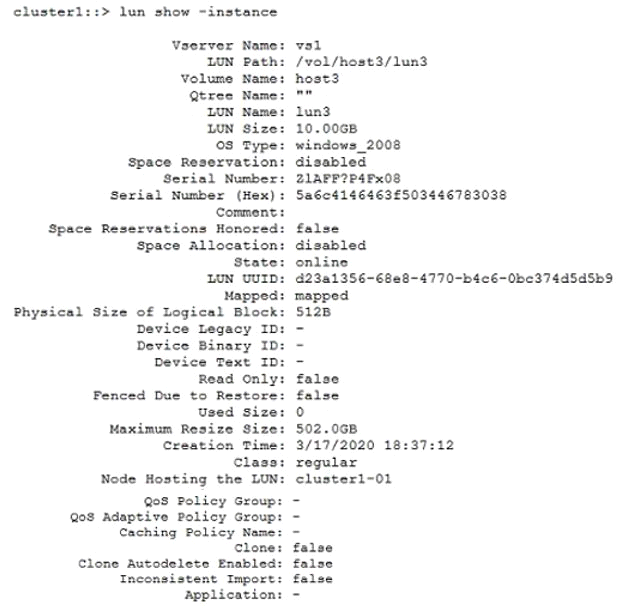NetApp NS0-520 NetApp Certified Implementation Engineer - SAN, ONTAP Exam Practice Test
You want to move a SAN LIF and preserve its configuration information and avoid rezoning the switch fabric. In this scenario, which two steps must be performed to fulfill this goal? (Choose two)
Answer : C, D
Moving SAN LIFs
If a node needs to be taken offline, you can move a SAN LIF to preserve its configuration information, such as its WWPN, and avoid rezoning the switch fabric. Because a SAN LIF must be taken offline
before it is moved, host traffic must rely on host multipathing software to provide nondisruptive access to the LUN. You can move SAN LIFs to any node in a cluster, but you cannot move the SAN LIFs
between storage virtual machines (SVMs).
Yoy can find more information on this link:
You are installing an AFF A250 system with ONTAP 9.8 software. Your customer asks you about the recommended LIF configuration for the ISCSI protocol. In this scenario, which two statements are correct
(choose two)
Answer : A, C
It is recommended that all SVMs in ISCSI configurations have a minimum of two LIF's per node in separate Ethernet networks for redundancy and MPIO across multiple paths.
You can find more information on this link:
You created a LUN in a new volume on your Netapp ONTAP cluster. You enabled the default snapshot schedule and enabled snapshot autodelete on the volume. In this scenario, in which three situations
does the snapshot autodelete feature automatically delete snapshot copies in the volume? (choose three)
Answer : A, C, D
Depending on what is selected in the 'Trigger' option, Snapshot Autodelete will automatically delete a snapshot when, either the volume space utilized, or the snapshot reserve reaches a threshold capacity
specified below.
Automatic deletion of Snapshot copies from flexible volumes Data ONTAP can automatically delete one or more Snapshot copies on the volume, provided the Data ONTAP Snapshot copy autodeletion
policy is enabled and set to trigger when the overwrite reserve is nearly full on the volume.
You can find more information on this link:
https://library.netapp.com/ecmdocs/ECMP1217281/html/GUID-98FB8EC4-F3AE-4D25-AF44-E3200AFEB1AB.html
File deletions from a SAN-attached host that is using Windows Server 2016 are not freeing up space in LUN lun3. Referring to the exhibit, which setting is preventing the SCSI UNMAP operation?
Answer : D
For clustered Data ONTAP, support for SCSI UNMAP begins in the 8.2 release family. For a LUN to advertise support for and accept SCSI UNMAP commands, enable the space-allocation option on LUNs which you expect to use this feature with.
You can find more information on this link:

A customer wants to deploy NVMe/FC along with an existing FC SAN fabric using ONTAP 9.8. In this scenario, which two actions are correct? (choose two)
Answer : A, B
Because NVMe/FC simply swaps command sets from SCSI to NVMe, it is an easy transition to make. NVMe/FC uses the same FC transport and therefore the same hardware from the host, through the
switch and all the way to the NVMe/FC target port on the storage array. Thus, NVMe/FC implementations can use existing FC infrastructure, including HBAs, switches, zones, targets, and cabling.
You can find more information on this link:
https://www.netapp.com/de/media/10681-tr4684.pdf
You are planning to install a new AFF All SAN Array A250 system and want to use persistent ports. In this scenario, what should be identical within the HA pair?
Answer : C

You can find more information on this link:
https://www.netapp.com/pdf.html?item=/media/10379-tr4515.pdf&v=20217121554 (11)
A customer is deploying a SAN cluster of A700 nodes and wants to ensure that the SAN cluster will maintain a quorum in the event of a rack level power failure. Which two statements are true in this scenario? (choose two.)
Answer : A, C
The quorum rule states that to make changes to the configuration in our cluster, we need to have more than half of the nodes available. This prevents configuration conflicts if we lose connectivity between the nodes in our cluster.
So, if we have only 2 racks and 4 nodes we could never get more than half of the nodes available if one of those racks power fails.
We need 6 nodes separated on 3 racks, so we can have more than half of the nodes available if one of those racks power fails.